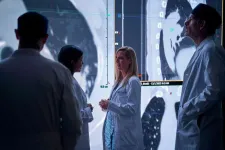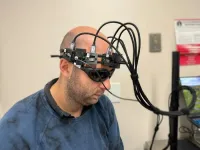(Press-News.org) WASHINGTON, September 30, 2024 — People with low- and intermediate-risk prostate cancer treated with either of two types of contemporary radiation therapy — proton beam therapy or intensity modulated radiation therapy (IMRT) — achieved equally high rates of tumor control with no differences in patient-reported quality of life, according to a first-of-its-kind phase III clinical trial comparing the two technologies. Findings of the PARTIQoL trial will be presented today at the American Society for Radiation Oncology (ASTRO) Annual Meeting.
“We tested two contemporary, advanced forms of external beam radiation for a very common cancer, and we demonstrated that both are very safe, effective treatments that give patients excellent outcomes in terms of quality of life and cancer control,” said Jason Efstathiou, MD, PhD, FASTRO, principal investigator of the trial and vice chair of faculty and academic affairs in the department of radiation oncology at Massachusetts General Hospital.
Patients diagnosed with localized prostate cancer, in which the cancer has not spread outside the prostate and may grow slowly, have many treatment options. About 70% of new prostate cancer cases — more than 200,000 people in the U.S. each year — are diagnosed as localized disease. And since many of these patients will survive their cancer and live many years after treatment, their quality of life becomes particularly paramount when making treatment decisions, Dr. Efstathiou said.
External beam radiation therapy is a common option for patients with localized prostate cancer. Most types of this therapy use photon beams, the same radiation used in lower doses for x-rays. Photon beams can reach tumors deep inside the body but scatter bits of radiation along the way, which can lead to side effects in the area treated. IMRT, for example, is an advanced form of photon-based radiation that allows oncologists to shape and modulate the radiation beams to conform to the three-dimensional shape of a tumor.
Another external-beam option — proton therapy — uses protons rather than photon beams. These charged particles kill cancer by producing a sudden burst of energy once they stop inside a tumor. Because this release happens directly at the tumor site, protons deliver less radiation along their path and are potentially less likely to harm surrounding healthy tissue. This increased precision also comes with significantly higher costs, however. The specialized equipment and facilities required for proton therapy are less widely available than those for IMRT and the treatment can be substantially more expensive.
“Patients now have many options for how they might manage their prostate cancer, but trying to sift through all of the information to understand the consequences for their quality of life can be confusing,” said Dr. Efstathiou, who is also professor of radiation oncology at Harvard Medical School. “To aid them in making these decisions, we compared two of the most advanced forms of external beam radiation, IMRT and proton beam therapy, head-to-head.”
Between June 2012 and November 2021, Dr. Efstathiou and his colleagues randomly assigned 450 patients with low- or intermediate-risk localized prostate cancer enrolled from 29 recruiting centers to receive either proton therapy or IMRT, without hormonal therapy. The median age was 68 years old. Patients were asked to self-report bowel, urinary and sexual functions via questionnaires at baseline and at multiple timepoints after treatment; median follow-up was 60.3 months.
No differences were observed between the IMRT and proton arms for any of the quality of life domains at any timepoint, and patients treated with either technique reported only small, clinically non-meaningful declines from baseline levels. For example, patients reported average bowel function scores of 93.7 (IMRT) and 93.5 (protons) out of 100 at baseline; after two years, the averages were 91.8 and 91.9, respectively, for a decrease of roughly 2% for each arm (p=0.836).
The groups also did not differ in progression-free survival. Five years after treatment, 93.7% and 93.4% of patients treated with IMRT and protons, respectively, had not experienced tumor progression (p=0.706).
“We can use either of these tools with comparably excellent outcomes,” Dr. Efstathiou said. “There have been so many advances in the delivery of contemporary radiation — such as the incorporation of scanned and modulated beams and in-room imaging — that I think the potential gaps between these technologies have narrowed over time.”
There also were no sustained differences in quality of life or survival between the arms for any pre-defined subgroups: low vs. intermediate risk disease, older vs. younger than 65, yes vs. no rectal spacer use and shortened vs. conventional fractionation schedule. Dr. Efstathiou explained that analyses are continuing on this large dataset, however.
“There may be subgroups that benefit from one technology over another, and we’re actively continuing analyses of that,” he said, noting that the study only compared the efficacy of each technology for patients with localized prostate cancer and not more advanced stages of the disease.
Dr. Efstathiou said the completion of this trial is also a win for the field, which relies on advanced technologies that can be difficult to assess in a randomized controlled trial.
“Providing the best evidence-based care calls for rigorously testing the tools we use for that care. We commonly use randomized controlled trials to evaluate new drugs, for example, but not necessarily for new technologies,” he said. “I hope that our work shows that randomized, controlled trials are critical in technology assessment.”
###
Attribution to the American Society for Radiation Oncology (ASTRO) Annual Meeting is requested in all coverage.
Study/Presentation Details
Abstract LBA 01: Prostate Advanced Radiation Technologies Investigating Quality Of Life (PARTIQoL): Phase III randomized clinical trial of proton therapy vs. IMRT for localized prostate cancer
News Briefing: Monday, September 30, 10:00 a.m. Eastern time. Details here. Register here.
Scientific Presentation: Monday, September 30, 1:30 p.m. Eastern time, Walter E. Washington Convention Center. Email press@astro.org to access the livestream or recording.
Funding: Federal Share of program income earned by Massachusetts General Hospital on C06 CA059267, Proton Therapy Research and Treatment Center, and additional funding from the Prostate Cancer Foundation (PCF)
ABOUT ASTRO
The American Society for Radiation Oncology (ASTRO) is the largest radiation oncology society in the world, with more than 10,000 members who are physicians, nurses, biologists, physicists, radiation therapists, dosimetrists and other health care professionals who specialize in treating patients with radiation therapies. Radiation therapy contributes to 40% of global cancer cures, and more than a million Americans receive radiation treatments for cancer each year. For information on radiation therapy, visit RTAnswers.org. To learn more about ASTRO, visit our website and follow us on social media.
END
IMRT and proton therapy offer equally high quality of life and tumor control for people with prostate cancer
Multi-center, phase III trial finds photon- and proton-based radiation therapies similarly safe and effective
2024-09-30
ELSE PRESS RELEASES FROM THIS DATE:
Timing matters when adding immunotherapy to chemoradiation for patients with limited-stage small cell lung cancer
2024-09-30
WASHINGTON, September 30, 2024 — People with limited-stage small cell lung cancer may benefit from adding immunotherapy to chemoradiation, but not if both treatments are given at the same time, new research finds. The results suggest that the timing of when immunotherapy is given plays a key role in its ability to extend survival. Findings of the multi-institutional phase III trial, which also found that twice-daily radiation treatments offer greater survival benefits than once-daily treatment, will be presented today at the American Society for Radiation Oncology (ASTRO) Annual Meeting.
The ...
Existing standard chemoradiation superior to deintensification approaches for HPV-related oropharyngeal cancer
2024-09-30
WASHINGTON, September 30, 2024 — Researchers looking to de-intensify radiation treatments for people with early-stage, HPV-associated oropharyngeal cancer to prevent long-term side effects halted a large, randomized phase II/III trial after patients in the control arm reached a record high, two-year progression-free survival rate of 98%. De-intensified treatments involving a lower radiation dose and immunotherapy in place of chemotherapy did not perform as well as the more rigorous chemoradiation approach. Findings of the NRG Oncology HN005 trial will be presented today at the American Society for Radiation Oncology (ASTRO) Annual ...
CAR-T safe and effective on an outpatient basis in community hospitals
2024-09-30
(WASHINGTON – September 30, 2024) In the largest prospective study to date examining the use of chimeric antigen receptor (CAR)-T therapy in a community setting on an outpatient basis, patients with relapsed or refractory large B-cell lymphoma (LBCL) responded well to treatment with few serious side effects, according to results published today in Blood Advances.
LBCL is a cancer affecting B lymphocytes, a type of white blood cell. It can progress rapidly and is fatal if untreated, although most forms of LBCL respond well to standard ...
City of Hope to present leading-edge radiotherapy treatments for people with lung, genitourinary and blood cancers at the American Society for Radiation Oncology Annual Meeting
2024-09-30
LOS ANGELES — City of Hope®, one of the largest and most advanced cancer research and treatment organizations in the U.S. and ranked among the nation’s top 5 cancer centers by U.S. News & World Report, is part of today’s press conference program at the American Society for Radiation Oncology (ASTRO) Annual Meeting, where a renowned City of Hope radiation oncologist will present phase 3 clinical trial data showing that people with limited-stage small cell lung cancer may benefit from adding immunotherapy to chemoradiation, but not if both treatments are given at the same time. The results suggest that the timing of when immunotherapy is given plays a key role in its ...
A new and unique fusion reactor comes together with PPPL's contributions
2024-09-30
Like atoms coming together to release their power, fusion researchers worldwide are joining forces to solve the world’s energy crisis. Harnessing the power of fusing plasma as a reliable energy source for the power grid is no easy task, requiring global contributions.
The Princeton Plasma Physics Laboratory (PPPL) — a U.S. national laboratory funded by the Department of Energy (DOE) — is leading several efforts on this front, including collaborating on the design and development of a new fusion device at the University of Seville in Spain. The SMall Aspect Ratio Tokamak (SMART) strongly ...
Reduced risk of serious cardiovascular disease after COVID vaccination
2024-09-30
People who have been fully vaccinated against COVID-19 have a significantly lower risk of developing more severe cardiovascular conditions linked to COVID-19 infection, according to a nationwide study at the University of Gothenburg. At the same time, some cardiovascular effects are seen after individual doses of the vaccine.
The COVID-19 vaccine aims to reduce complications and overall mortality from the disease. At the same time, some cardiovascular effects have been seen after individual doses of the vaccine. A rare acute side effect is inflammation of the cardiac muscle or the pericardium in young men following mRNA vaccination. In terms of other cardiovascular ...
New laser-based headset can measure blood flow, assess risk of stroke
2024-09-30
When physicians want to know more about a patient’s risk of cardiovascular disease, they can order a cardiac stress test. But when it comes to risk of stroke, there is no equivalent scalable and cost-effective test of the brain’s function to help physicians counsel patients on their potential risk. A questionnaire that asks patients about contributing risk factors is currently the best tool for estimating such risk.
Now a team of engineers and scientists from Caltech and the Keck School ...
Researchers close in on understanding possible cause of Alzheimer’s disease
2024-09-30
CLEVELAND—With a four-year, $3.3 million grant from the National Institutes of Health (NIH), researchers from Case Western Reserve University will study whether certain brain proteins may play a role in the development of Alzheimer’s disease.
Alzheimer’s disease is a brain disorder that slowly destroys memory and thinking skills. According to the Alzheimer’s Association, nearly 7 million Americans 65 and older are living with the disease and there are more deaths from Alzheimer’s than breast and prostate cancer combined.
Previous research has ...
New synthesis strategy could speed up PFAS decontamination
2024-09-30
HOUSTON – (Sept. 30, 2024) – Rice University engineers have developed an innovative way to make covalent organic frameworks (COFs), special materials that can be used to trap gases, filter water and speed up chemical reactions. COFs have the potential to address significant environmental challenges, including energy storage and pollution control. An example of that is their potential use in the decontamination of “forever chemicals” or per- and polyfluoroalkyl substances (PFAS).
Rice chemical engineer Rafael Verduzco and his team have described a new way to synthesize high-quality ...
COVID-19 linked to increased risk of acute kidney disorders: New study reveals time-varying effects
2024-09-30
Researchers from West China Hospital, Sichuan University, have conducted a study revealing a significant association between COVID-19 and acute kidney disorders (AKD), including acute kidney injury (AKI), that varies over time. The study, led by Dr. Li Chunyang and Dr. Zeng Xiaoxi from the West China Biomedical Big Data Center, was recently published in the journal Health Data Science.
COVID-19, known for its impact on the respiratory system, also affects other organs, including the kidneys. The study aimed to investigate the time-dependent effects of COVID-19 on acute kidney disorders. Using data from the ...
LAST 30 PRESS RELEASES:
First Editorial of 2026: Resisting AI slop
Joint ground- and space-based observations reveal Saturn-mass rogue planet
Inheritable genetic variant offers protection against blood cancer risk and progression
Pigs settled Pacific islands alongside early human voyagers
A Coral reef’s daily pulse reshapes microbes in surrounding waters
EAST Tokamak experiments exceed plasma density limit, offering new approach to fusion ignition
Groundbreaking discovery reveals Africa’s oldest cremation pyre and complex ritual practices
First breathing ‘lung-on-chip’ developed using genetically identical cells
How people moved pigs across the Pacific
Interaction of climate change and human activity and its impact on plant diversity in Qinghai-Tibet plateau
From addressing uncertainty to national strategy: an interpretation of Professor Lim Siong Guan’s views
Clinical trials on AI language model use in digestive healthcare
Scientists improve robotic visual–inertial trajectory localization accuracy using cross-modal interaction and selection techniques
Correlation between cancer cachexia and immune-related adverse events in HCC
Human adipose tissue: a new source for functional organoids
Metro lines double as freight highways during off-peak hours, Beijing study shows
Biomedical functions and applications of nanomaterials in tumor diagnosis and treatment: perspectives from ophthalmic oncology
3D imaging unveils how passivation improves perovskite solar cell performance
Enriching framework Al sites in 8-membered rings of Cu-SSZ-39 zeolite to enhance low-temperature ammonia selective catalytic reduction performance
AI-powered RNA drug development: a new frontier in therapeutics
Decoupling the HOR enhancement on PtRu: Dynamically matching interfacial water to reaction coordinates
Sulfur isn’t poisonous when it synergistically acts with phosphine in olefins hydroformylation
URI researchers uncover molecular mechanisms behind speciation in corals
Chitin based carbon aerogel offers a cleaner way to store thermal energy
Tracing hidden sources of nitrate pollution in rapidly changing rural urban landscapes
Viruses on plastic pollution may quietly accelerate the spread of antibiotic resistance
Three UH Rainbow Babies & Children’s faculty elected to prestigious American Pediatric Society
Tunnel resilience models unveiled to aid post-earthquake recovery
Satellite communication systems: the future of 5G/6G connectivity
Space computing power networks: a new frontier for satellite technologies
[Press-News.org] IMRT and proton therapy offer equally high quality of life and tumor control for people with prostate cancerMulti-center, phase III trial finds photon- and proton-based radiation therapies similarly safe and effective






